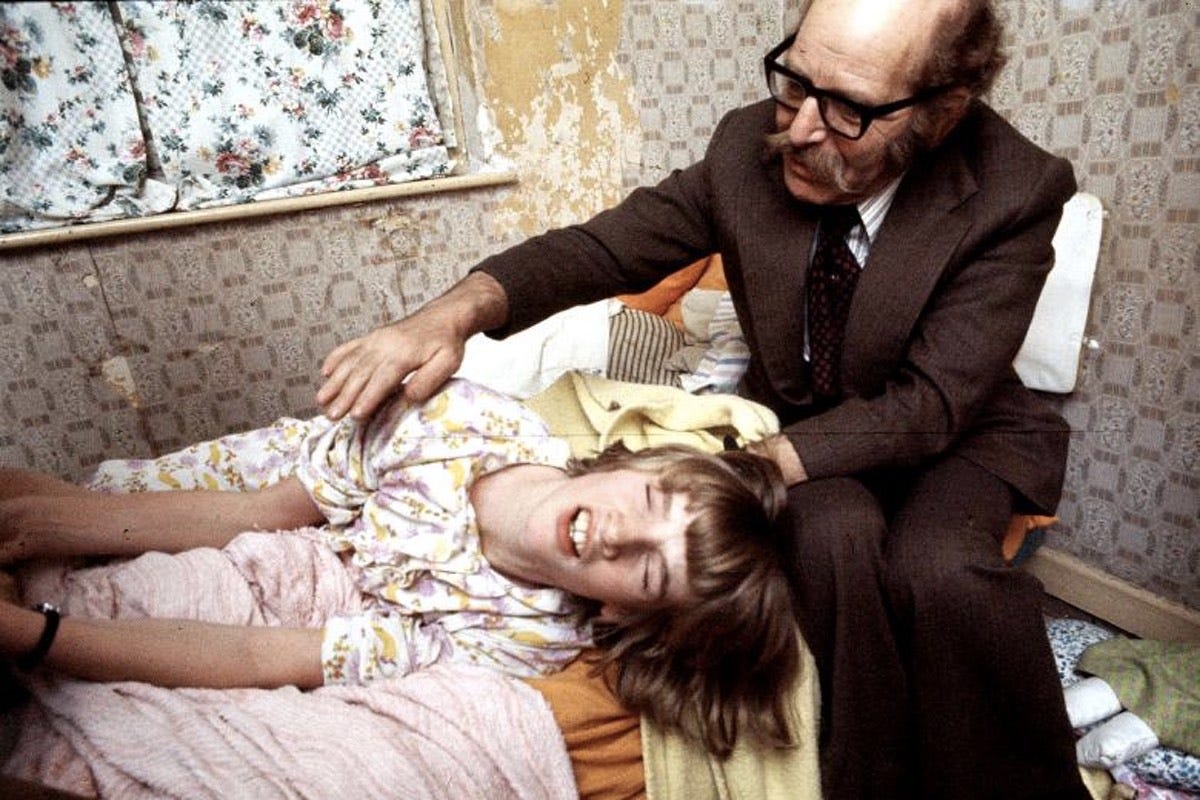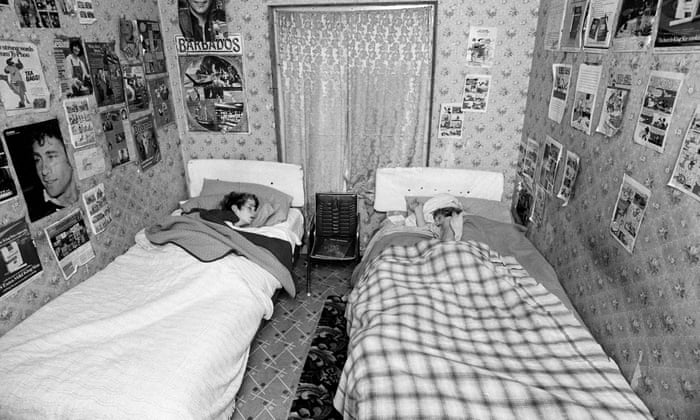Enfield poltergeist
 The Enfield poltergeist was a claim of supernatural activity at 284 Green Street, a council house in Brimsdown, Enfield, England, between 1977 and 1979 involving two sisters, aged 11 and 13. Some members of the Society for Psychical Research such as inventor Maurice Grosse and writer Guy Lyon Playfair believed the haunting to be genuine, while others such as Anita Gregory and John Beloff were "unconvinced" and found evidence the girls had faked incidents for the benefit of journalists. Members of the Committee for Skeptical Inquiry, including stage magicians such as Milbourne Christopher and Joe Nickell, criticized paranormal investigators for being credulous whilst also identifying features of the case as being indicative of a hoax.
The Enfield poltergeist was a claim of supernatural activity at 284 Green Street, a council house in Brimsdown, Enfield, England, between 1977 and 1979 involving two sisters, aged 11 and 13. Some members of the Society for Psychical Research such as inventor Maurice Grosse and writer Guy Lyon Playfair believed the haunting to be genuine, while others such as Anita Gregory and John Beloff were "unconvinced" and found evidence the girls had faked incidents for the benefit of journalists. Members of the Committee for Skeptical Inquiry, including stage magicians such as Milbourne Christopher and Joe Nickell, criticized paranormal investigators for being credulous whilst also identifying features of the case as being indicative of a hoax.
The story attracted considerable press coverage in British newspapers such as the Daily Mail and Daily Mirror, and has been the subject of books, featured in television documentaries, and dramatized in horror films.
Claims
 In August 1977 single parent Peggy Hodgson called the police to her rented home in Enfield, claiming she had witnessed furniture moving and that two of her four children said that knocking sounds were heard on walls. The children included Margaret, age 13, and Janet, 11. A police constable said that she saw a chair "wobble and slide" but “could not determine the cause of the movement”. Later claims included disembodied voices, loud noises, thrown toys, overturned chairs, and children levitating. Over 18 months, more than 30 people, including neighbors, psychic researchers, and journalists, said they variously saw heavy furniture moving of its own accord, objects being thrown across a room and the daughters seeming to levitate several feet off the ground. Many also heard and recorded knocking noises and a gruff voice. The activity in the house attracted considerable press attention and the story was covered in British newspapers such as the Daily Mail and Daily Mirror until reports came to an end in 1979.
In August 1977 single parent Peggy Hodgson called the police to her rented home in Enfield, claiming she had witnessed furniture moving and that two of her four children said that knocking sounds were heard on walls. The children included Margaret, age 13, and Janet, 11. A police constable said that she saw a chair "wobble and slide" but “could not determine the cause of the movement”. Later claims included disembodied voices, loud noises, thrown toys, overturned chairs, and children levitating. Over 18 months, more than 30 people, including neighbors, psychic researchers, and journalists, said they variously saw heavy furniture moving of its own accord, objects being thrown across a room and the daughters seeming to levitate several feet off the ground. Many also heard and recorded knocking noises and a gruff voice. The activity in the house attracted considerable press attention and the story was covered in British newspapers such as the Daily Mail and Daily Mirror until reports came to an end in 1979.Investigations
Paranormal
 Society for Psychical Research members Maurice Grosse and Guy Lyon Playfair reported "curious whistling and barking noises coming from Janet's general direction." Although Playfair maintained the haunting was genuine and wrote in his later book This House Is Haunted: The True Story of a Poltergeist (1980) that an "entity" was to blame for the Enfield disturbances, he often doubted the children's veracity and wondered if they were playing tricks and exaggerating. Still, Grosse and Playfair believed that even though some of the alleged poltergeist activity was faked by the girls, other incidents were genuine. Other paranormal investigators who studied the case include American demonologists Ed and Lorraine Warren. The Warrens visited the Enfield house in 1978 and were convinced that the events had a supernatural explanation.
Society for Psychical Research members Maurice Grosse and Guy Lyon Playfair reported "curious whistling and barking noises coming from Janet's general direction." Although Playfair maintained the haunting was genuine and wrote in his later book This House Is Haunted: The True Story of a Poltergeist (1980) that an "entity" was to blame for the Enfield disturbances, he often doubted the children's veracity and wondered if they were playing tricks and exaggerating. Still, Grosse and Playfair believed that even though some of the alleged poltergeist activity was faked by the girls, other incidents were genuine. Other paranormal investigators who studied the case include American demonologists Ed and Lorraine Warren. The Warrens visited the Enfield house in 1978 and were convinced that the events had a supernatural explanation. Janet was detected in trickery; a video camera in the room next door caught her bending spoons and attempting to bend an iron bar. Grosse had observed Janet banging a broom handle on the ceiling and hiding his tape-recorder. According to Playfair, one of Janet's voices she called "Bill" displayed a "habit of suddenly changing the topic—it was a habit Janet also had".When Janet and Margaret admitted "pranking" to journalists, Grosse and Playfair compelled the girls to retract their confession. They were mocked by other researchers for being easily duped.
Janet was detected in trickery; a video camera in the room next door caught her bending spoons and attempting to bend an iron bar. Grosse had observed Janet banging a broom handle on the ceiling and hiding his tape-recorder. According to Playfair, one of Janet's voices she called "Bill" displayed a "habit of suddenly changing the topic—it was a habit Janet also had".When Janet and Margaret admitted "pranking" to journalists, Grosse and Playfair compelled the girls to retract their confession. They were mocked by other researchers for being easily duped. The psychical researcher Renée Haynes had noted that doubts were raised about the alleged poltergeist voice at the Second International SPR Conference at Cambridge in 1978, where video cassettes from the case were examined. The SPR investigator Anita Gregory stated the Enfield case had been "overrated", characterizing several episodes of the girls' behavior as "suspicious" and speculated that the girls had "staged" some incidents for the benefit of journalists seeking a sensational story. John Beloff, a former president of the SPR, investigated and suggested Janet was practicing ventriloquism. Beth Beloff and Gregory came to the conclusion that Janet and Margaret were playing tricks on the investigators.
The psychical researcher Renée Haynes had noted that doubts were raised about the alleged poltergeist voice at the Second International SPR Conference at Cambridge in 1978, where video cassettes from the case were examined. The SPR investigator Anita Gregory stated the Enfield case had been "overrated", characterizing several episodes of the girls' behavior as "suspicious" and speculated that the girls had "staged" some incidents for the benefit of journalists seeking a sensational story. John Beloff, a former president of the SPR, investigated and suggested Janet was practicing ventriloquism. Beth Beloff and Gregory came to the conclusion that Janet and Margaret were playing tricks on the investigators.Other
 American magician Milbourne Christopher briefly investigated, failed to observe anything that could be called paranormal and was dismayed by what he felt was suspicious activity on the part of Janet. Christopher would later conclude that "the poltergeist was nothing more than the antics of a little girl who wanted to cause trouble and who was very, very clever."Ventriloquist Ray Alan visited the house and concluded that Janet's male voices were simply vocal tricks.
American magician Milbourne Christopher briefly investigated, failed to observe anything that could be called paranormal and was dismayed by what he felt was suspicious activity on the part of Janet. Christopher would later conclude that "the poltergeist was nothing more than the antics of a little girl who wanted to cause trouble and who was very, very clever."Ventriloquist Ray Alan visited the house and concluded that Janet's male voices were simply vocal tricks.
Comments
Post a Comment